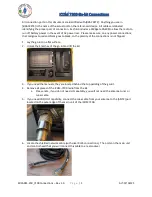
MAX-M10S - Integration manual
MINACQTIME
The receiver tries to obtain a position fix for at least the time given by MINACQTIME.
If the receiver determines that it needs more time for the given starting conditions then it will
automatically prolong this time. If MINACQTIME is set to zero, the receiver determines the time.
Once the MINACQTIME has expired, the receiver will terminate the acquisition state if either a fix is
achieved or if the receiver estimates that any signals received are insufficient (too weak or too few)
for a fix to be possible.
MAXACQTIME
This defines the maximum time that the receiver will spend in the "Acquisition"
state. If the receiver is unable to acquire a valid position fix within this maximum time, it will
transition to the "Inactive for search" state (if DONOTENTEROFF is disabled). Subsequently, the
receiver will attempt to acquire another position fix according to the search period ACQPERIOD. If
MAXACQTIME is set to zero, the receiver will autonomously determine the maximum time to spend
in the "Acquisition" state. Note that shorter settings (below about 45 s) will degrade an unaided
receiver's ability to collect new Ephemeris data at low signal levels.
DONOTENTEROFF
If this option is enabled, then when the receiver cannot get a fix it keeps
attempting to acquire a position fix instead of entering the "Inactive for search" state. In other
words, the receiver will never be in the "Inactive for search" state and therefore the search period
ACQPERIOD and the minimum acquisition time MINACQTIME will be ignored.
WAITTIMEFIX
A time fix is a fix type in which the receiver will ensure that the time is accurate and
confirmed to within the limits set in CFG-NAVSPG. Enabling the WAITTIMEFIX option will force the
receiver to stay in the "Acquisition" state until the time is known to be within the configured limits,
then it will transition to the "Tracking" state. Take into account that enabling WAITTIMEFIX will delay
the transition from the "Acquisition" state to the "Tracking" state by at least two extra seconds.
The quality of the position fixes can also be configured by setting the limits in the CFG-NAVSPG
group. Setting harder limits in CFG-NAVSPG will typically prolong the time in the "Acquisition" state.
When externally controlled, it is therefore necessary to ensure sufficient time for the receiver at
startup. Refer to
for more information. When internally controlled, the receiver
can make good judgment on the time needed in the "Acquisition" state and no further adjustments
will be needed.
UPDATEEPH
To maintain the ability of a fast startup, the receiver needs to update its ephemeris
data on a regular basis. This can be ensured by activating the update Ephemeris option
UPDATEEPH. The ephemeris data is updated approximately every 30 minutes. Refer to
for more information.
2.7.2.7 Satellite data download
The receiver is not able to download satellite data (e.g. the ephemeris) while it is working in on/off
or cyclic tracking operation. Therefore it has to temporarily switch to continuous operation for the
time the satellites transmit the desired data. To save power the receiver schedules the downloads
according to an internal timetable and only switches to continuous operation when data of interest
is being transmitted by the satellites.
Each satellite transmits its own ephemeris data. Ephemeris data download is feasible when the
corresponding satellite has been tracked with a sufficient C/N0 over a certain period of time. The
download is scheduled in a 30-minute grid or immediately when fewer than a certain number of
visible satellites have valid ephemeris data.
Almanac, ionosphere, UTC correction, and satellite health data are transmitted by all satellites
simultaneously. Therefore these parameters can be downloaded when a single satellite is tracked
with a sufficiently high C/N0.
UBX-20053088 - R03
2 Receiver functionality
Page 39 of 89
C1-Public
















































